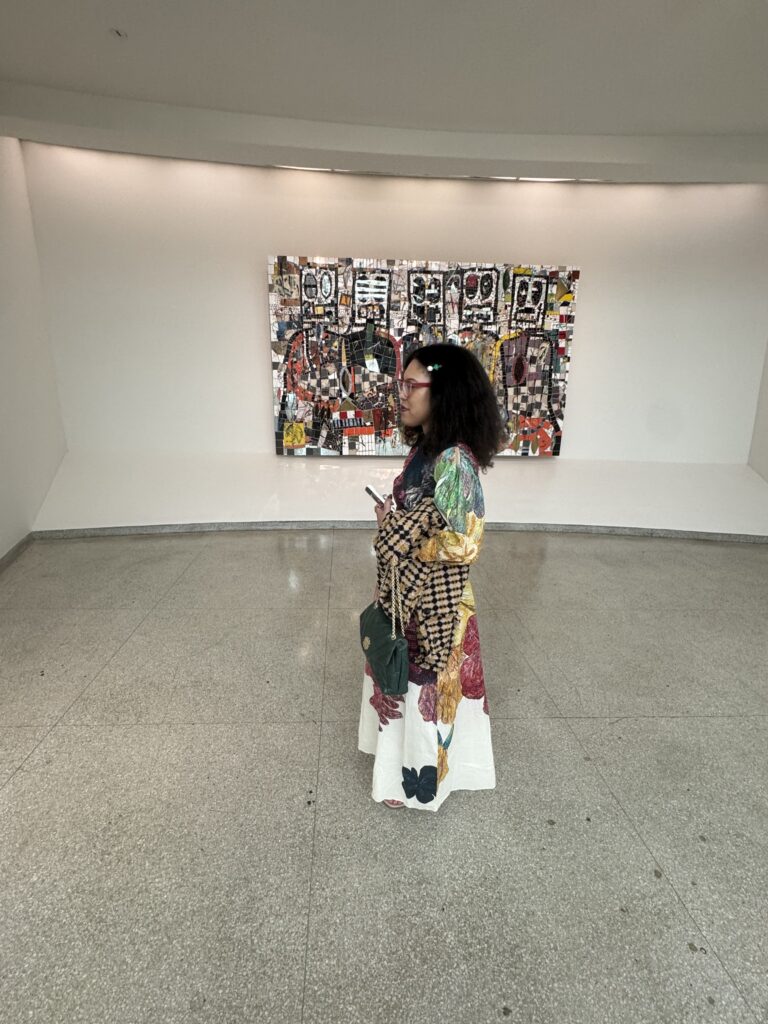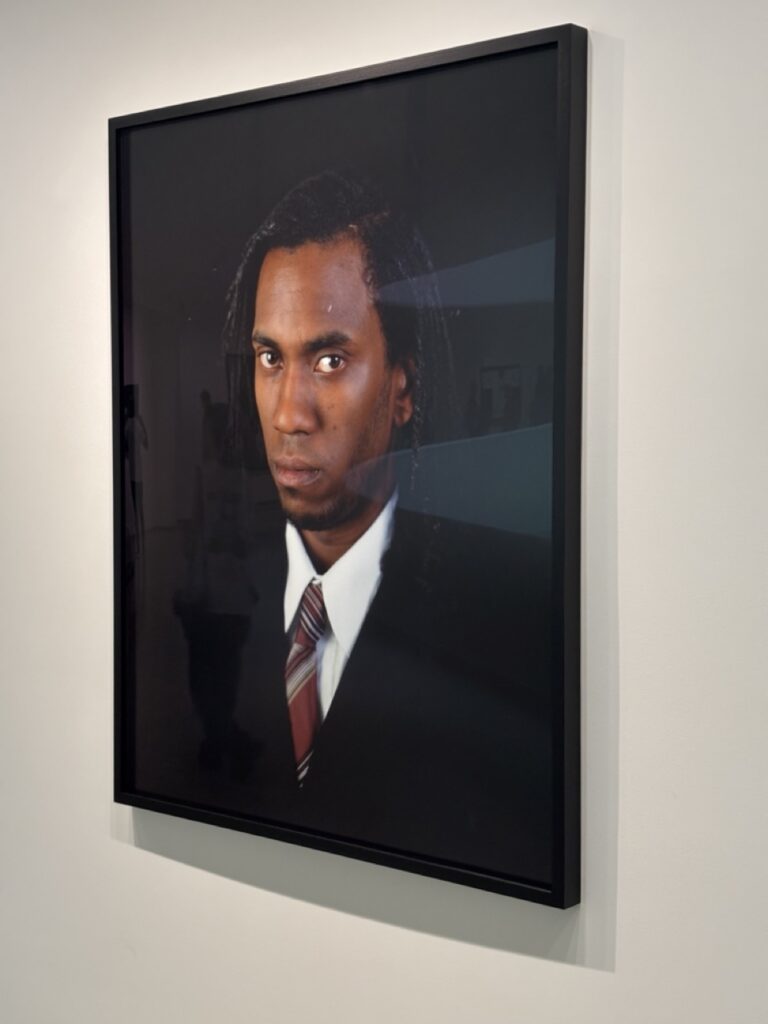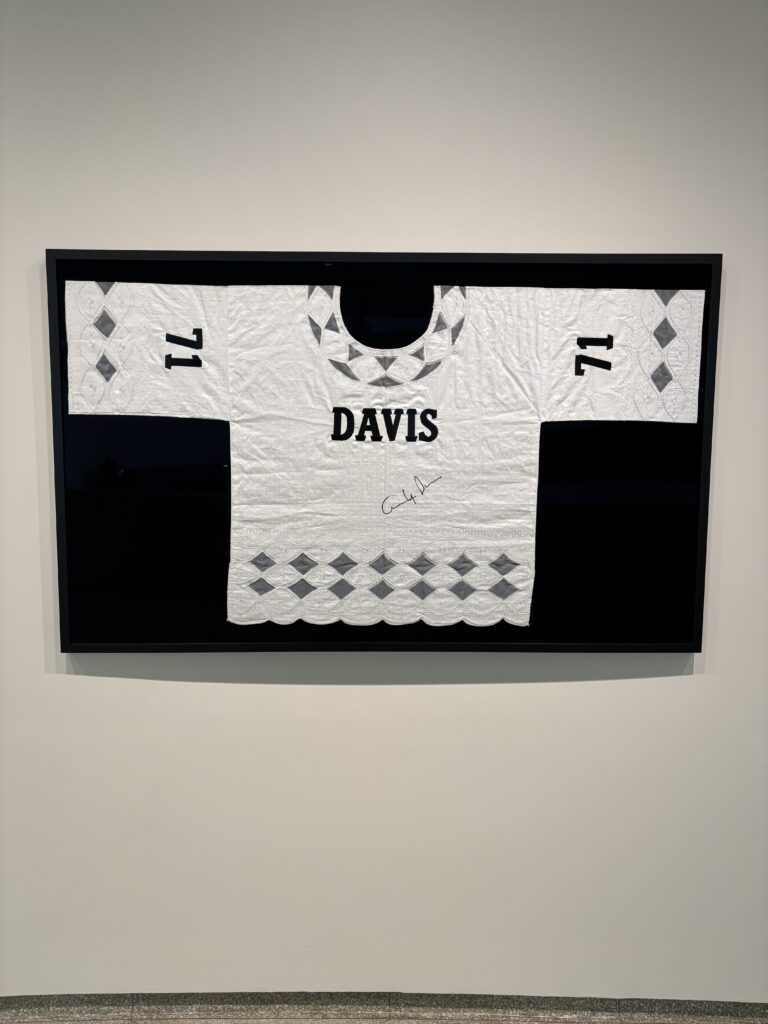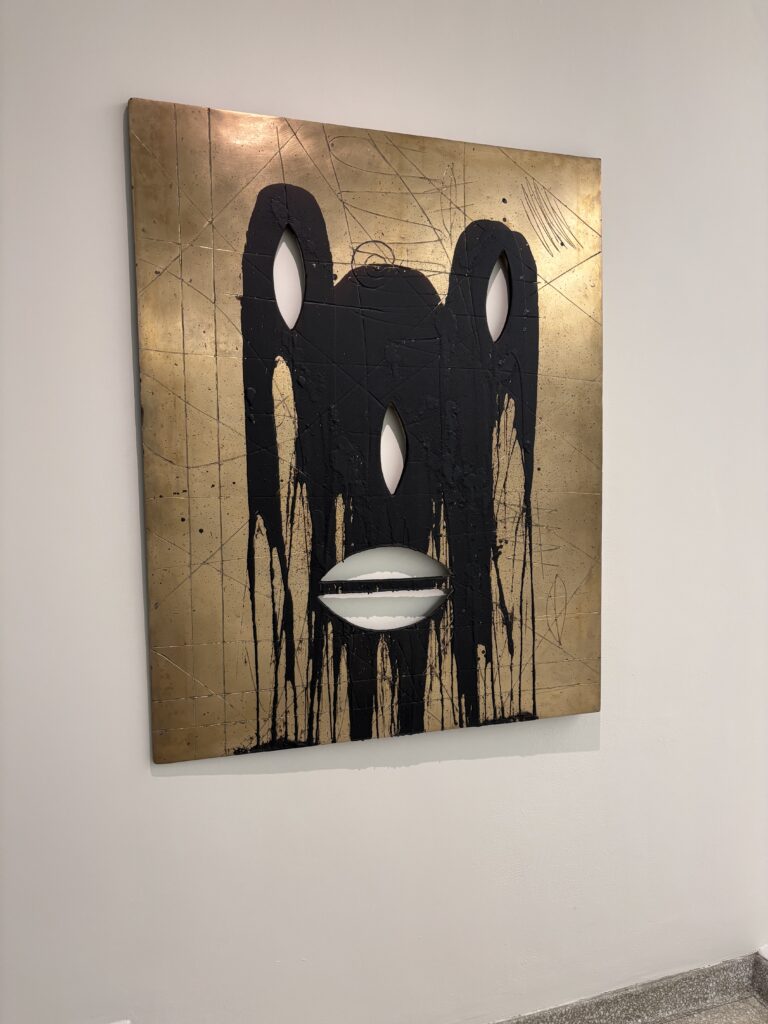
“Rashid Johnson: A Poem For Deep Thinkers” at the Guggenheim
The Guggenheim’s survey of Rashid Johnson’s work seems to occupy an alternate context.
On the first day of my required freshman social studies class, HIS 107: Survey of African-American History, the professor wrote the n-word on the board. Next, he conjugated it row by row, replacing the ‘er’ for usage in the present tense with I, you, he/she, and we. Yo niggo. Tú niggas. Él/Ella/Ud. nigga. Nosotros niggamos. (I don’t remember his point, but I thought college was off to a riveting start. He would go on to award me a C+ for the semester, the lowest grade I’d ever gotten in high school or college, and then write me a glowing recommendation letter for graduate school. In a post-script twist two years after I graduated, he was one of four people charged with drug distribution to prison inmates and was incarcerated for six months.)
I thought of his conjugation exercise when I later came across the term nigrescence. The -escent ending indicates a developing state or action. Iridescence combines irid (rainbow, from the Greek iris) with the -escent ending and means “beginning to be a rainbow.” Nigrescence, then, in a literal sense means “beginning to be Black.” I’d first seen the term while trying to process Paul Beatty’s 2015 bombshell of a book, The Sellout. I own one copy of the text. By my count, the artist Rashid Johnson has stacked at least twenty copies across various sculptures, and it would seem that the story (or at least the title) made an indelible impression on him.
The Guggenheim, which is the most visually striking building on Museum Mile, has filled its rotunda with a survey of Rashid Johnson’s artwork to date. Since Johnson is only in his 40’s I imagine this survey is one of two, three, or even four more that I’ll get to see in my lifetime. With more than 90 pieces of artwork, it combines his work across eras and across mediums, which for him seem to be intertwined. His self-portrait era where he posed himself as historical Black leaders like Frederick Douglass and Thurgood Marshall coincided with his photography era. His large scale sculptural works, which resemble a sort of jungly IKEA aesthetic, incorporate his shea butter carvings. I’d been looking forward to the show since December 2024, when they teased it in the New Yorker under the headline “The Confident Anxiety of Rashid Johnson”. This is not an amateur diagnosis on the part of the magazine, anxiety is another recurring theme in Johnson’s work.
Until the Guggenheim, I’d only ever seen two of Johnson’s works and each piece was isolated. First, I saw his sculpture “Untitled Stranger” in Flesh of the Earth, curated by Enuma Okoro at Hauser & Wirth. Second, I saw his painting (if you count black soap on tile as painting) “Untitled Anxious Man” in Edges of Ailey at the Whitney. In both cases, the work was contextualized. Johnson’s sculpture — live plants, soccer balls of shea butter, and provocatively-titled books atop a powder coated steel structure — made sense in a collection of artwork that highlights our interdependence with Earth. Johnson’s painting — a bewildered blockhead scribbled in soap drippings on tile — illustrated the tension that choreographer Alvin Ailey felt as a high-achieving, queer Black man in America with bipolar disorder. As a result, I came in to the show eager to learn about Johnson’s work within its own context, to know more about an artist who’s so often cited and exalted (and whose work I’ve enjoyed).
It’s possible that the survey, which is entitled “A Poem for Deep Thinkers”, is too deep for me. But if I can be honest (which is what I always strive to be with our Black Star Constellation) I think the show wasn’t designed for me or us. I think the show aims to keep things shallow, to sanitize the implications of the imagery, to use a lot of words to say very little. And I think all of this is an effort to ensure the intended viewer gets to stay comfy. I’ve narrowed it down to four examples, but as usual I encourage you to visit the show and decide for yourself.
Self-Portrait Laying on Jack Johnson’s Grave (2006)
Rashid Johnson lays as if deceased on top of a stately tomb marked with the name Johnson. The section ‘Death is a Good Start’ mentions Jack Johnson as a “legend” with no further explanation. Why might R. Johnson choose to lay on the grave of J. Johnson? What makes J. Johnson a legend? There is no biographical information about Jack Johnson, the American boxer who became the first Black Heavyweight Champion of the World in 1908 when his physical defeat of Tommy Burns signaled a symbolic defeat of Jim Crow. There was no mention of Jack’s public cavorting with white women, which could have been an interesting tie-in to how Johnson depicts himself awake in a blue bed next to a sleeping white woman in his film on the top floor.
Self-Portrait with My Hair Parted Like Frederick Douglass (2003)
Excerpts from the description read,
“Functioning as both a self-portrait and an homage, this early photograph positions Johnson as a contemporary iteration of Frederick Douglass, one of the most photographed figures of the 1800s….Through playful mimicry and call and response — traditions rooted in gospel services — the artist attempts to replicate Douglass’s pose and parted hairstyle a look so uncommon today that it verges on the humorous.”
Tell me, is this a homage or is it humorous satire? Who was Frederick Douglass and why was he one of the most photographed figures of the 1800s? Historian and writer Sarah Lewis argues that Douglass had his photo taken at every turn because he understood the power of images as a way to humanize Black people in the eyes of the Nation and the world, which was a key part of his abolition work. It’s interesting to me that Johnson’s image is framed as an attempt at silly dress-up and in the same sentences draws on the significance of Black gospel traditions, meanwhile the context of the original image is one of a man seeking freedom for his people. I see no appropriate entry point to a punchline here.
Signed Angela Davis “Civil Rights All Stars” Throwback Dashiki Jersey (2003)
Excerpts from the section entitled ‘(Ir)reverence’ read,
“The quotes he utilizes…are evidence of his active intellect and, like many of the hip-hop generation, his ability to remix and repurpose those objects and gestures into altogether new forms. For instance, Signed Angela Davis “Civil Rights All Stars” Throwback Dashiki Jersey pays tribute to the venerable educator and organizer but recasts her as a sports star, likening politics to game theory.”
This feels like a missed opportunity to use words meaningfully or instructively. There are a number of phrases in the sentence that conceal: hip-hop generation, venerable educator and organizer, game theory. Here’s how I would explain it in plain language, “Johnson, who is 48, grew up immersed in hip-hop, basketball, and his parent’s activism. Here, he honors Angela Davis, one of the only remaining highly visible leaders of the Black Panther Party, with a throwback jersey. Among basketball fans, wearing the jersey of a retired player is a way to recognize the player’s continued influence on the game. In this way, Johnson elevates Davis’s status to that of basketball legends like Michael Jordan and Kobe Bryant.” The title of the show comes from an Amiri Baraka poem, I think it’s safe to say that Johnson is doing something more specific than “likening politics to game theory.”
Untitled Anxious Men (series of 3, 2015)
Excerpts from the label read,
“In Untitled Anxious Men, Johnson delves into visual expressions of anxiety, particularly in relation to Black masculinity, parenthood, and the systemic failures that leave Black children abandoned and unsupported. This exploration is especially poignant as it occurred in the mid-2010s, a period when high-profile cases of police brutality gained widespread attention. These pieces reflect the artist’s personal struggle to soothe these internal and external anxieties during major life transitions, while also questioning how art can act as a cathartic tool. Drawing from spaces of cleansing, prayer, and relief…. Johnson offers both individual and collective release.”
What a relief, through simply observing Johnson’s work at a museum, that I might be released from the weight of the Black plight. How nice to read briefly of high-profile cases of police brutality without having to picture faces or remember my reactions to Michael Brown’s murder in Ferguson, Tamir Rice’s murder in Columbus, or Laquan McDonald’s murder in Chicago which all happened in 2014. ‘Systemic’ is the only word here that hints that there may be a reason for Black men’s anxiety, but the vagueness of the word ‘failure’ unfairly implies that the fault could be on anyone.
In each of these examples, the narrating voice of the exhibit has used impressive words and intelligent phrases to talk around race. Terms like Black, Black identity, Black culture are included throughout, but the only mention of ‘white’ refers to a grid of bathroom tiles. (My imperfect method of analysis: I had ~32 photos of labels or walls of text at the exhibition. When I searched ‘white’ it returned one result. When I searched ‘black’ it returned 18 photos.) We cannot have a serious conversation about Blackness without acknowledging whiteness. Describing shower walls is not going to cut it. Blackness is a distinct identity; I’m still Black whether there are white people around or not. However, Angela Davis’s activism with the Panthers does not make sense without whiteness. If whiteness was not an insidious creeping vine, Frederick Douglass would just be one man with a ‘humorous’ side part and perhaps history would not need to remember him at all. If whiteness was not dangerous, Tamir Rice might go out this evening and have a drink with his college roommate. I believe that Rashid Johnson knows this, but I’m not convinced that the Guggenheim’s curatorial team shares this understanding. I don’t mean to rob Mr. Johnson of agency, surely if he thought the labels were problematic he would’ve spoken up. But, since whiteness suffocates and silences, I can’t help but wonder if they heard him.
The idea of nigrescence — which is a theme in The Sellout, the book Mr. Johnson incorporates into a number of his structures — comes from the work of Dr. William E. Cross, Jr. who published a theory of Black identity development called Shades of Black in 1991. The structure of the theory of nigrescence, which has since been applied to a number of other identities like gender, sexuality, and other races, is pre-encounter, encounter, immersion, emersion, and internalization. The encounter stage, which is the moment you realize you are Black (or at least that you realize that you are not white) kicks off the racial identity development journey. This show, despite its repeated references to Black identity, Black history, Black people, and Black liberatory ideals, is situated in the ‘pre-encounter’ phase. It has not yet considered itself in relation to whiteness, immersed itself in the history, rejected performative-ness, and internalized its identity. The show has not experienced nigrescence, has not nigressed, is not nigressive. I think that’s why I can’t understand it.
The labels and descriptions are conjugated for a tense that doesn’t exist, a reality where Blackness is an aesthetic and whiteness need not be named. We don’t live in that tense and neither does the full power of Johnson’s work. This allows the intended audience to come and see without leaving and thinking. It prioritizes comfort and visage. It’s unfortunate, that without the right attention paid to context, the message for deep thinkers, casual viewers, and anyone at the Guggenheim is lost in translation.
blacklove 🖤 and starlight 🌟
“Rashid Johnson: A Poem for Deep Thinkers” opened at the Guggenheim Museum on April 18, 2025 and will run through January 18, 2026. Admission to the Guggenheim is $28 for adults. Admission is pay what you wish on Mondays and Saturdays from 4:00pm until close at 5:30pm. Advance reservations are suggested.
- Interior view of the exhibition in the Guggenheim’s rotunda
- “Self-Portrait Laying on Jack Johnson’s Grave”(2006) by Rashid Johnson
- Still from a film by Rashid Johnson
- “Self-Portrait with My Hair Parted Like Frederick Douglass” (2003, printed 2025) by Rashid Johnson
- “Signed Angela Davis “Civil Rights All Stars” Throwback Dashiki Jersey”(2003) by Rashid Johnson
- All titled “Untitled Anxious Men” (2015) by Rashid Johnson
- “Untitled (Shea Butter Table)” (2016) by Rashid Johnson
- “Roadrunner” (2015) by Rashid Johnson
- “The Shuttle” (2011) by Rashid Johnson
- “Stay Black and Die (from the series “Things I need to do”)” (2005) by Rashid Johnson















